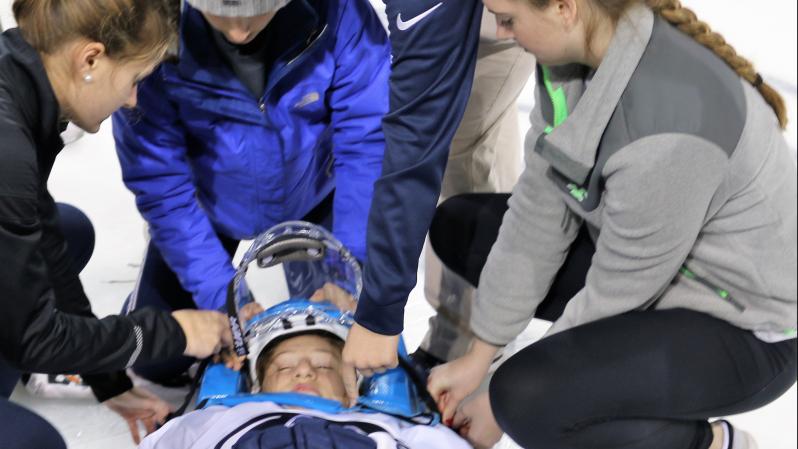Clinical Education

Pre-Professional Phase Clinical Observation Experiences
Prior to potential application, and admission to the Athletic Training (ATHTR) major, prospective students enrolled in the Pre-Professional Phase are assigned to two separate clinical observations in two different athletic training facilities on campus. Each observation lasts approximately seven weeks, and takes place under the supervision of an assigned staff athletic trainer serving as a preceptor for the curriculum. These experiences provide potential applicants with the opportunity for exposure to a variety of clinical education sites associated with the major as a means of gaining insights into athletic training as a career as well as the unique, and rigorous demands of the degree program at Penn State.
Professional Phase Clinical Education Experiences
Upon acceptance to the major, athletic training students complete formal clinical education experiences that are associated with required clinical practice, and practicum courses. As part of each student’s clinical education plan, they will be assigned to a variety of different clinical education sites, and practice settings in an effort to expose them to an array of experiences in athletic training, and the healing arts in treating diverse populations from varying socioeconomic backgrounds, and cross-sections of the lifespan.
Non-Orthopaedic Exposures Primary Assignments
Athletic training students complete five semester-long primary clinical education assignments, which are progressively modeled to prepare them to learn, develop, acquire and apply the foundational knowledge, skills, and abilities/attitudes required to effectively serve as a competent athletic trainer.

All students will be required to complete a different primary clinical education assignment each semester in order to fulfill the specific requirements of the current model. This entails that students are exposed to diverse populations that engage in various modes of physical activity, and/or sport, which contain the following elements:
- Accreditation-Required
- Individual physical activity or sport participation
- Team sport participation
- Equipment intensive physical activity or sport
- Female population in physical activity or sport
- Male population in physical activity or sport
- Programmatic-Recommended
- Lower extremity focused physical activity or sport
- Upper extremity focused physical activity or sport
Non-Orthopaedic Exposures, and Non-Sport Population Cycles
Embedded within primary assignments are non-orthopaedic exposures, and non-sport population cycles that facilitate athletic training student exposures to varying general, and specific medical conditions as well as disciplines of the healing arts.
Non-orthopaedic exposures provide students with the opportunity to apply their clinical skills in providing care for different general, and/or specific medical conditions in the primary assignment with patients that may be considered athletes participating in organized competitive sports (e.g. high school, collegiate, professional, etc.), and/or in a non-sport population cycle.
In non-sport population cycles, athletic training students are provided with the opportunity to perform their inclusive clinical skill set in managing various health-related conditions (e.g. orthopaedic, and general medical) for samples of the general population, which are NOT the athletes they interface with as part of their primary assignment.
Communicable Disease Policy
Students are required to immediately report to the Program staff any change in their health that would affect their ability to care for patients (especially any infectious diseases). The Program may require the student to obtain medical clearance before returning to clinical sites. Failure to report these health changes is a serious breach in professional responsibilities since health care providers, and the program have a responsibility to protect the patients who are engaged in the health care setting. Failure to report these potential health care issues may result in dismissal from the Program. We have a responsibility to notify the clinical Preceptors if a student is at risk for causing potential harm to patients or other members of the health care team. Students may need to be pulled from clinical sites until a potential infection is remedied.
Clinical Education Requirements and Clearances
- Parameters on Student Health, Technical Standards and Practicum Attendance
- Immunizations/Vaccinations and Physical Examination Requirements
- Bloodborne Pathogens and Procedures for Determining Student Health
- Physical Examination Form
- Infectious Disease Summary
- Penn State Student Waiver Form
- Professional Liability Insurance for Students
- Information for Completing Publicly Available Background Checks
Clinical Education Database Portal
- www.atrackonline.com (Access restricted to ATHTR personnel only)
